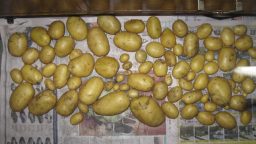If you have your own garden and:
- You’ve used all your canning supplies
- Your freezer is full
- Your friends refuse to take any fresher produce off your hands
Chances are you may need to consider an alternative method of storing your crops rather than just letting them all rot in their earthy homes.
In cases like these, a good root cellar is an excellent alternative to mass vegetable homicide.
However, unless you already have a handy hole dug in the ground complete with a door to keep out foraging animals. You may need a viable alternative. Fear not! Alternatives do live among us and for your convenience, we’ve compiled a list just for you.
So, without further ado, here are 4 alternatives to a traditional root cellar.
Metal Can Root Cellar
What you’ll need:
- A Metal Trash Can and lid
- Waterproof tarp or other covers
- Straw
- Shovel
How to Do It:
This couldn’t be simpler. Dig a hole deep and wide enough to fit the can into with 3-4 inches left above the ground level. Set the can into the hole and backfill the dirt around the can. Fill the can with your root produce and put on the lid. Pile several inches of straw on top of the lid and cover with the tarp to keep out rain and hold the straw in place.
5 Gallon Root Cellar
What you’ll need:
- 5-gallon bucket with lid
- Drill
- Shovel
- Straw (optional)
How to Do It:
Similarly, to the metal can version, dig a hole to fit all but the top 3-4 inches of the bucket. Drill several holes in the bottom of the bucket to provide drainage for any moisture that may get in.
Fill the bucket with the veggies, place the lid, cover with straw.
Upcycle a Fridge or Freezer
What you’ll need:
- Old Chest freezer/fridge
- 15-20’ of 3-4” diameter PVC pipe
- 2 PVC elbow connectors
- 2 PVC T connectors
- Tarp
- Shovel
How to Do It:
Remove all the working parts. If your unit still has Freon, you’ll need to have a pro remove and dispose of it properly.
Once everything not needed is gone, cut two holes centered vertically on each side the diameter of your PVC pipe. Measure and cut your PVC pipe to fit into the connectors when they are attached to the holes you cut into each side. Attach the piping combos to the holes cut into the sides. These provide air circulation to avoid mold and mildew from developing and spoiling what’s being stored.
Once the “plumbing” is in place, bury the unit up to the bottom of the lid.
Suggested Article: “5 Simple Methods to Preserve Food”
The Zeer Pot
What you’ll need:
- One small unglazed clay pot with a lid
- One large unglazed clay pot
- Sand
- Duct Tape
How to Do It:
This idea is based on an ancient way of keeping water cool in the desert or other hot regions. The general mechanics involve taking advantage of the cooling process that takes place when an object sweats.
Like our bodies also do when we sweat, a vessel made of porous material, like terracotta clay, will cool as the small amount of moisture that seeps through the pores evaporates. This evaporation creates a cool enough environment inside the vessel that would rival any crisper drawer GE or Maytag can develop.
Depending on the size of the pots you are using, you will probably want to put together your Zeer pot in the location you are going to keep it. Otherwise, you may be stuck with lugging a very heavy contraption across your patio. You’ll want to keep it in a shaded location that provides good air circulation around the pot.
Begin by using the duct tape to seal the premade hole at the bottom of each pot. Next, add an even layer of sand to the bottom of the larger pot, just deep enough so that when you place the smaller pot on top of it, the rims of both pots are even with each other.
How to Store Food All Winter Long…
While keeping the smaller pot centered inside the big pot, fill the area in between with the sand and pack down. Once you’ve filled that area between the two pots with sand and evened it out on top, start adding water. Continue to carefully add water until the sand is completely soaked.
Clean out any sand and water that may have splashed or fallen into the inner pot.
Cover the inner pot with a lid, then cover the whole Zeer with a damp cloth. This will expedite the initial cooling process so you can start storing items more quickly. If you weren’t able to find a lid the right size, the damp cloth would work well on its own. Once the inside has had the chance to cool, fill it with your produce and replace the lid.





